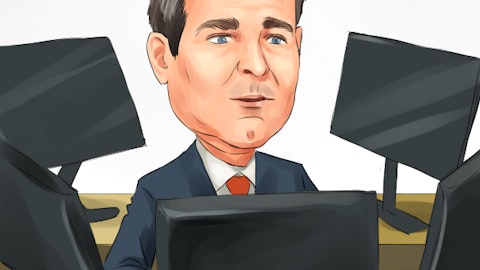Not only that, we’ve also proven that in the last five years that you can teach an old dog new tricks. Palo Alto Networks, which was a single product in one lane, we had the best firewall technology in the world as well as had amazing services that worked in the firewall, we have been able to take that and build multiple products across multiple security swim lanes and make them work better together. And the only way you can do that in security is you have to keep driving innovation. You have to stay at the bleeding edge because you don’t need your customers to be at the bleeding edge. It is our responsibility as a security company to make sure we take all the innovation, we distill it, we make it work in an integrated fashion and deliver it to our customers at the fastest pace possible because the bad actors are not waiting, they’re constantly looking for ways to get to our customers, to get to penetrate their infrastructure and try and figure out how to go extract data from our customers or possibly hold them with ransomware.
So we have taken what was an amazing company in one category and actually built what we’d like to say is an innovation engine that allows us to stay at the bleeding edge. We’ve also done that, to be honest, not just by doing it ourselves because the fact that the cybersecurity industry has 3,000 startups out there, which are constantly funded because they’re all working in a specialist way to solve more problems, which they believe is important for the end customer, we have to be vigilant and make sure that we don’t have any issues in either building it for our customers or partnering or acquiring something that’s out there that is important as part of the security fabric that we need to deliver to our customers. So as a team, we’re really excited that where we are in our sort of juncture today allows us to go forward and build an even better, larger and a more compelling business for our shareholders.
Not only that, to deliver phenomenal security outcomes for our customers across all these categories that we see inflecting as well as categories that we believe will be created in the next three to five years. So with that in mind, if you think about what’s our view going forward for the next three to five years or possibly the next decade, I said in the last five years, we saw that huge sort of technology trends, underlying it of cloud and AI allowed us to create the stitching to build what I would say, the building blocks of building the world’s largest cybersecurity company actually prepares us phenomenally well for what we think lies ahead. What we think lies ahead is the need for security to stop bad actors mid-flight, real-time, as it’s happening.
If you think about security today, the industry is only 30% or 40% real time. You know a bad URL, you know a bad DNS. You know how to stop your customers from something that is bad that we know. What we still aren’t good at as an industry is being able to figure out unknowns and stop them before they happen. To do that, it requires a fundamentally different way of thinking about security. Something we have been sort of leading having a point of view on. And that is the idea of having stitched products that work from end to end. The idea that as something is happening, you’re able to analyze it real time, on the fly and understand it’s good or bad. It is reducing the noise of security in the industry by eliminating all these super close alerts or the bad signal to noise ratio.
So to get that right or to get security right, we will have to be more and more real time as an industry. Now we sit at a point where everybody is talking about AI. And actually, that is the solution. The solution is to make sure you ingest large amounts of data, you analyze them on the fly, and you’re able to deliver superior security. Something we talked about just in our Q4 earnings call, right before this, you saw that everything we’re doing in XSIAM is driving us to that vision. But that’s not enough. We have to make sure every platform that we have continues to grow and continues to get more and more ubiquitous with our customers, at the same time, also stitches these things together. So we believe in the next five to 10 years, we’re going to see this shift, which is going to be palpable.
It is going to be big. It’s going to be understandable where we have to become more and more real time. It will no longer be about putting a bunch of sensors and thinking about hygiene and security policies. It will be about how do you stop a bad act. And we’ll talk more about this because today, the mean time to fix a bad act as we’ve talked to you about in our earnings is four to six days. That’s not acceptable. This thing will have to go down to minutes and near real time. So that’s a big shift we see that’s going to drive a lot of the innovation in our industry. That’s going to drive a lot of our strategy and our vision because we think we’re on our way to be able to deliver that future to our customers as the world’s largest cybersecurity company.
In that context, we talked about those three categories. We think those three categories are going to continue to become bigger. And if you look at it, the biggest opportunity is that big green circle of security operations and automation because we think the current paradigm is broken. The current paradigm is a reactive security paradigm. It’s the paradigm we say, let’s hire three more million people to solve security problems. No, I don’t think that’s going to solve the problem. What’s going to solve the problem is, let’s collect good data, let’s analyze good data. Let’s find out the anomalous behavior. Let’s block it while it’s happening, so our customers have a better security outcome. I think that’s where we’re going to be going. And we’re going to have a phenomenal opportunity at Palo Alto Networks to go ahead and address a $200 billion market, which is primarily going to be a software-based market, which has its own benefits across the board because it’s a lower cost of ownership for our customers, lower cost of integration for our customers.
It’s easy for us to go deploy and keep our customers all at — what is the best and current best in — sort of best-in-class capability. So a future that is driven by software capability, a future that’s driven by software solutions with security and a future which has integration as part of so — as part of it as a key tenet with the objective of delivering a real-time autonomous security outcome. So that’s where we think the world is going, that’s where we’d like to be, and we think we’re best positioned in the industry to be able to deliver that future. Not only that, to deliver great security outcomes to our customers. So with that in mind, how are we going to do this? What are we doing in the next three years, how is that going to translate into numbers that are loved by our shareholders?




